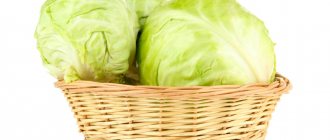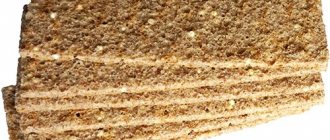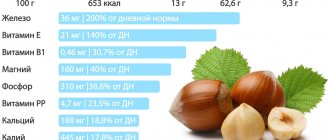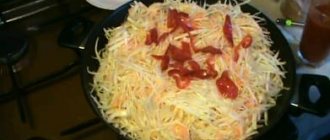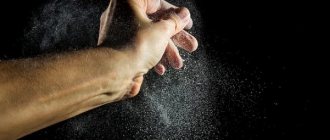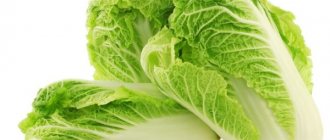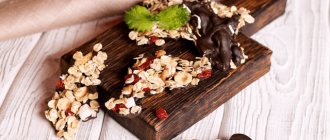The heroine of this article is a well-known snack - pickled cabbage: beneficial properties, calorie content and how to use the product for various diseases. After all, many people make homemade preparations for the winter without even thinking about all the beneficial and harmful properties of the vegetable!
To make an incomparable crispy snack and get the expected result, you need to know some secrets about the vegetable itself.
Chemical composition of the cabbage species
100 grams of pickled white cabbage contains:
- proteins – 1.07 g;
- fat – 1.50 g;
- carbohydrates – 8.60 g.
White pickled cabbage includes micro- and macroelements, namely:
| Micro- and macroelements | Quantity per 100 g |
| Mono- and disaccharides | 4 g |
| Water | 94.7 g |
| Ash | 0.85 g |
| Starch | 0.07 g |
| Organic acids | 115 g |
| Alimentary fiber | 4.6 g |
| Potassium | 279.1 mg |
| Sodium | 22 mg |
| Calcium | 59.1 mg |
| Phosphorus | 28.4 mg |
| Magnesium | 15 mg |
| Sulfur | 38.8 mg |
| Bor | 184.9 mcg |
| Copper | 76.9 mcg |
| Aluminum | 528.5 mcg |
| Fluorine | 9.5 mcg |
| Chromium | 4.8 mcg |
| Iodine | 2.9 mcg |
| Manganese | 0.1657 mg |
| Molybdenum | 13.5 mcg |
| Chlorine | 1802.1 mg |
| Cobalt | 3.3 mcg |
| Zinc | 0.3881 mg |
| Nickel | 0.3881 mg |
| Iron | 0.8 mg |
In addition to the above elements, cabbage, in its composition, is enriched with such vitamins as:
| Vitamin name | Quantity per 100 g |
| Vitamin C | 41.5 mg |
| Vitamin B9 – folate | 8.97 mcg |
| Vitamin B1 – thiamine | 0.027 mg |
| Vitamin B6 – pyridoxine | 0.2 mg |
| Vitamin B2 – riboflavin | 0.039 mg |
| Vitamin E (TE) | 4.7 mg |
| Vitamin H – biotin | 0.08 mcg |
| Vitamin B5 – pantothenic | 0.3 mg |
| Vitamin A | 0.03 mg |
| Vitamin A (VE) | 20.1 mcg |
| Vitamin PP | 0.7 mg |
| Vitamin PP – niacin equivalent | 0.8853 mg |
Chemical composition and calorie content of pickled cabbage
Pickled white cabbage retains all the same beneficial substances that are found in fresh vegetables. In addition, these substances remain in pickled vegetables longer, since the marinade, in addition to its taste, has preservative properties.
Did you know? American Chiney discovered in 1942 that cabbage juice contains the substance S-methylmethionine, which perfectly heals ulcers. This substance was later named vitamin U.
Listed below are the most significant minerals and vitamins contained in the product.
Minerals (mg/100 g):
| potassium | 138 |
| calcium | 29 |
| magnesium | 7,3 |
| sodium | 12,25 |
| sulfur | 19 |
| phosphorus | 13,9 |
| aluminum | 0,25 |
| boron | 0,1 |
| iron | 0,4 |
| iodine | 0,0015 |
| copper | 0,04 |
| molybdenum | 0,0066 |
| nickel | 0,007 |
| fluorine | 0,0047 |
| chromium | 0,0022 |
| zinc | 0,2 |
Vitamins (mg/100 g):
| A | 0,01 |
| IN 1 | 0,01 |
| AT 2 | 0,02 |
| AT 5 | 0,08 |
| AT 6 | 0,06 |
| AT 9 | 0,0047 |
| WITH | 21,0 |
| E | 0,038 |
| N | 0,047 |
| RR | 0,44 |
| RR | 0,33 |
BZHU (g/100 g):
| calories | 62 kcal |
| squirrels | 1 |
| fats | 5,3 |
| carbohydrates | 2,88 |
Of course, the calorie content depends on the composition of the marinade. If the marinade was made with a lot of butter and sugar, then there will be more calories in such a product.
Do you know the difference between sauerkraut and salted cabbage?
Chemical composition of kelp
100 grams of marinated sea cabbage contains:
- proteins – 0.93 g;
- fat – 0.25 g;
- carbohydrates – 1.8 g.
The indicators of micro- and macroelements in pickled seaweed are as follows:
| Micro- and macroelements | Quantity per 100 g |
| Water | 0.87 g |
| Ash | 0.08 g |
| Organic acids | 38.1 g |
| Alimentary fiber | 1.1 g |
| Calcium | 42.6 mg |
| Phosphorus | 53.9 mg |
| Magnesium | 165.7 mg |
| Potassium | 945.3 mg |
| Sodium | 509.5 mg |
| Sulfur | 1.9 mg |
| Manganese | 0.0026 mg |
| Copper | 2.8 mcg |
| Molybdenum | 1.5 mcg |
| Iron | 15.8 mg |
| Cobalt | 0.2 mcg |
| Zinc | 0.0059 mg |
| Chlorine | 574.4 mg |
Vitamins that are included in seaweed:
| Vitamin name | Quantity per 100 g |
| Vitamin C | 1.85 mg |
| Vitamin B9 – folate | 2.5 mcg |
| Vitamin B1 – thiamine | 0.05 mg |
| Vitamin B6 – pyridoxine | 0.03 mg |
| Vitamin B2 – riboflavin | 0.07 mg |
| Vitamin PP | 0.45 mg |
| Vitamin PP – niacin equivalent | 0.5495 mg |
| Vitamin A | 0.2 mg |
| Vitamin A (VE) | 103 mcg |
Calorie content of quick-cooking pickled cabbage per 100 grams
Calorie content of instant pickled cabbage per 100 grams is 58 kcal. In 100 g of product:
- 1.1 g protein;
- 5.5 g carbohydrates;
- 3.6 g fat.
Read: Calorie content of pumpkin cream soup
To quickly prepare pickled cabbage you need:
- pour 2 liters of water into a saucepan, mix water with 1 glass of sugar, 4 tablespoons of salt, 5 allspice peas, 4 bay leaves;
- bring water to a boil, add 100 ml of 9 percent vinegar, 1 glass of vegetable oil;
- boil the resulting mixture for another 1 minute;
- chop 3 kg of white cabbage into small pieces, add 5 cloves of crushed garlic and one onion, cut into half rings, to the cabbage. Mix everything;
- pour hot brine over the cabbage and leave for 16 hours at room temperature;
- cabbage is ready to eat after 16 – 18 hours.
How is the white cabbage variety useful?
Important! Pickled white cabbage, when properly stored, can retain all its vitamins for more than seven months. At the same time, it even acquires additional benefits by combining with other components that are necessary and important for humans.
Pickled cabbage contains a minimal amount of acid , unlike fermented sorbate, which means that it is easier on the digestive system.
All the beneficial properties of such cabbage cannot be counted, but there are several main ones:
- Pickled cabbage, when consumed regularly, immediately increases the protective functions of the immune system and helps cope with stress and fatigue.
- Helps improve intestinal function, and when consuming pickled cabbage, all metabolic processes in the body are accelerated.
- Due to a sufficient amount of vitamins, it prevents the occurrence of vitamin deficiency, thereby limiting us from consuming synthetic vitamin preparations during the off-season.
Contraindications for use
In its structure, cabbage is enriched with a significant amount of coarse plant fiber . This information tells us that in some cases its use can lead to intestinal flatulence. The following dish should not be included:
- for indigestion;
- colitis;
- if the acidity of the stomach is increased;
- with enteritis;
- in case of myocardial infarction.
Attention! Nursing mothers should use pickled cabbage with caution; due to its properties, such a dish can cause bloating or intestinal upset.
The benefits of pickled white cabbage
Beneficial properties of pickled white cabbage:
- the product is low in calories and contains a small amount of fat, so it can be included in the diet when dieting and losing weight;
- with regular consumption of such cabbage, the functioning of the nervous system improves, resistance to stress increases, and intestinal microflora is normalized;
- the rich vitamin composition of the snack allows it to be used to prevent and prevent vitamin deficiency;
Read: Calorie content of boiled salmon
- pickled white cabbage is enriched with vitamin C, which normalizes the body’s immune functions;
- amino acids in the dish restore protein balance in the body, reduce the level of bad cholesterol in the blood, and have an antimicrobial effect;
- pickled cabbage stimulates blood circulation and has a beneficial effect on the condition of gums and teeth;
- Nicotinic acid contained in cabbage accelerates the breakdown of fats and carbohydrates.
The benefits of kelp
Is pickled seaweed healthy? Of course yes. At the moment, scientists continue to discover new beneficial properties of kelp, which leads to an increase in demand for such a useful product.
Sea kale, also known as kelp, is widely used not only as a food product, but also in medicine and cosmetology.
Numerous vitamins and elements of seaweed give it a number of beneficial qualities.:
The iodine contained in kelp is not destroyed during any heat treatment, which allows a person to obtain a sufficient amount of this element for his life without worrying about the method of its preparation.- Eating seaweed prevents atherosclerosis and blood clots.
- Being a kind of “cleaner” for blood vessels, it does not allow cholesterol to accumulate on their walls.
- Laminaria normalizes metabolic processes and replenishes and maintains the necessary water balance in the body.
During the diet, it is necessary to avoid pickled seaweed , since the spices used in the marinade may have a negative effect on obtaining the desired effect.
Contraindications for use
Important! In addition to the obvious benefits, pickled seaweed can also cause harm to health.
Having many vitamins and mineral elements in its composition, kelp has a number of contraindications for certain groups of people, namely :
- People who are allergic, intolerant or hypersensitive to iodine are strictly prohibited from consuming such a product.
- Laminaria should not be included in the diet of a child under 3 years of age.
- Pregnant women should exclude or minimize the intake of seaweed in their diet, since the iodine in its composition can cause abnormalities in the fetus.
- Those suffering from furunculosis, as well as people with kidney diseases, are not recommended to consume seaweed.
When choosing seaweed, pay attention to where it came from, or rather where it grew . This plant is capable of absorbing from its environment (sea water) not only useful, but also harmful substances, and if the place of growth was in polluted waters, it is better not to consume such cabbage.
We bring to your attention recipes for making pickled cabbage: with beets in Georgian style, in Gurian style, with turmeric, in a hot marinade, with bell pepper or chili, in Korean, with garlic, pieces, with carrots and other vegetables.
How to pickle cabbage
There are a huge number of different recipes for preparing snacks, but in our material we will limit ourselves to only some general recommendations:
- The stronger and harder the head of cabbage used for preparing the dish, the crispier it will be.
- For pickling, buy solid, strong, medium-sized forks; slightly flattened heads of cabbage work well for this purpose.
- Try not to use large amounts of vinegar to prepare the marinade.
- It is better to use natural apple or grape vinegar. When purchasing such a product, pay attention to the fact that the label indicates that it is “natural apple cider vinegar 6%” and not “table vinegar with apple or grape juice concentrate.” Also, keep in mind that this type of vinegar (natural) usually has a concentration of 6%, and not 9%, like table vinegar. That is, 6% apple cider vinegar should be taken 1.5 times more than indicated in the recipe, if it is a 9% product.
- If a nursing mother will eat pickled cabbage, do not use recipes that include beets, onions and garlic (in pellets) - it is better to prepare the marinade using a small amount of carrots.
- To prepare snacks, use undamaged enamel dishes, glass or porcelain containers.
- It is better to remove the bay leaf after the marinade has cooled so that it does not give off bitterness.
- The thinner the vegetable is chopped, the sooner it will marinate.
- There are recipes for quick preparation of the dish - most often, speed is achieved through fine shredding, high marinade temperature and a large amount of vinegar. If the speed of preparation is important to you (for example, guests suddenly arrive), use a similar recipe. However, if cooking time is not critical, then it is better to cook according to a recipe with less vinegar and using a cold marinade.
Late or autumn cabbage is suitable for pickling (as well as for pickling), but early cabbage is not at all suitable.
Pickled cabbage is a very tasty healthy dish that has a minimum number of contraindications. It is easy to prepare, and the ingredients for cooking are inexpensive. With a little effort, you can make a wonderful snack from a simple set of ingredients.
Is pickled cabbage good for your diet?
The low-calorie vegetable contains almost no fat: therefore, it is ideal for people on a diet. And at the same time it perfectly satisfies hunger.
Another useful property is that it is able to remove cholesterol and harmful substances from the body.
The benefits of pickled cabbage as a quick-cooking dietary product for the body are undeniable, and harm can only occur if it is taken in the morning on an empty stomach and in the evening before bed.
The optimal combination would be to use it with lean meat: this way animal protein is better absorbed.
